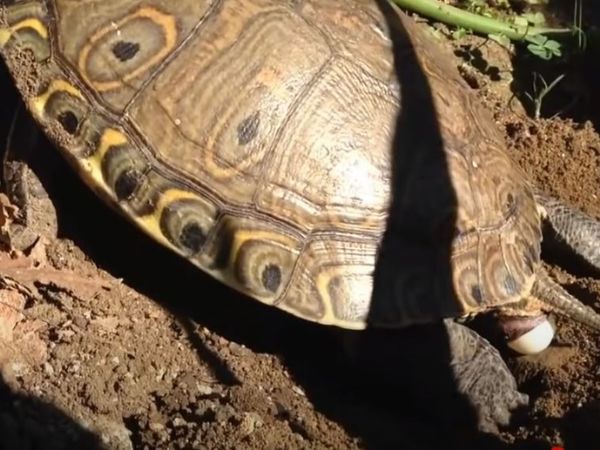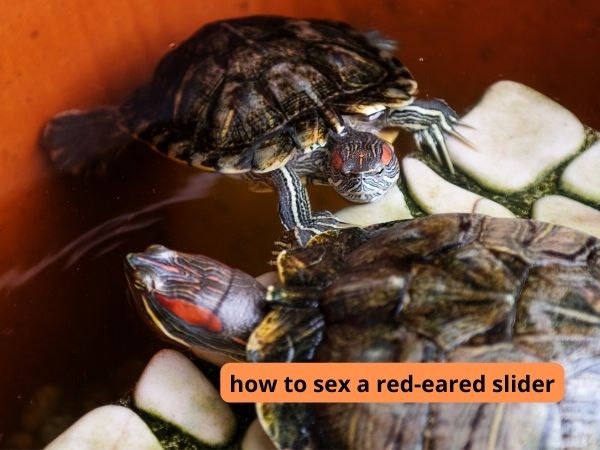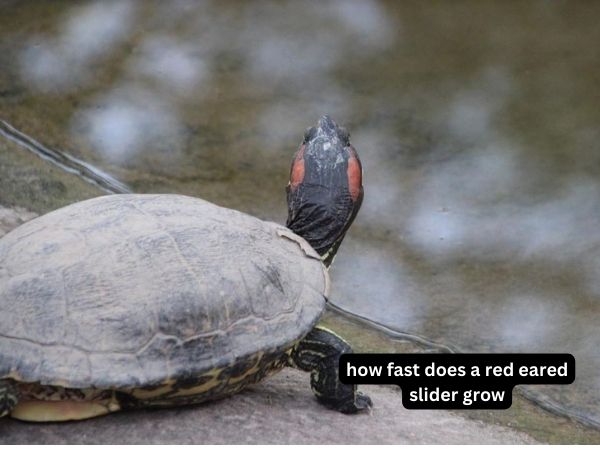red eared slider eggs: A short details
Red eared slider eggs are medium-sized, elliptical, and cream-colored eggs with a reddish-brown spot on one end. They typically measure 2″ long and 1.5″ wide. The female will excavate a nesting chamber in soft earth, often close to water, and lay her eggs within.
She will then cover the eggs with more soil and vegetation, which provides them with camouflage and protection from predators. incubation takes place over a period of 2-3 months, during which time the female will remain close by, guarding her eggs. Once they hatch, the young turtles will make their way to the water where they will start their life.
red-eared slider egg laying:
Female red-eared sliders lay eggs in a variety of habitats, including water (natural or man-made) and moist terrestrial sites. They often deposit their eggs near the water’s edge in thick grass, among aquatic plants, or on logs or branches overhanging the water.
The female typically selects a site and then digs a hole with her hind legs. She deposits her egg into the hole, covers it up with soil, and then kicks sand or dirt over the nest site to camouflage it. The typical clutch size is 10-12 eggs but can range from 2-30 eggs. Incubation time is about 60 days. After hatching, slider turtles are independent and fend for themselves from day one!
Set Up a Red-Eared Slider Egg Incubator:
Hatch some baby turtles with this guide to setting up an incubator for red eared slider eggs. You’ll need a container, moist media, and a heat source to get started.
- First, you’ll need to set up your incubation container. A plastic storage bin or aquarium works well for this purpose. Make sure that the container has smooth sides so that the turtles can’t climb out. Fill the container with moist media such as vermiculite, sphagnum moss, or perlite.
- The media should be moist but not wet; too much moisture can cause the eggs to rot. Next, place the eggs on top of the moist media. Cover the eggs with more moist media or put them in an egg carton to prevent them from drying out.
- Now you’ll need to provide a heat source for the eggs. A reptile heat mat placed underneath the container will work well. You’ll also need a thermometer to make sure that the temperature stays between 80 and 86 degrees Fahrenheit.
- Too much heat can cause the eggs to stop developing, while too little heat prevents them from hatching. Check the incubator’s temperature several times a day and make adjustments as necessary.
unfertilized red eared slider eggs:
Unfertilized red eared slider eggs will not hatch. The embryo will die within a few days and the eggshell will dry out. If you are incubating eggs, you can handle them (shine a light through them to see if there is any movement inside) at around day 10 to determine if they are fertile or not. Fertile eggs will be translucent and have a dark spot on the yolk where the embryo is developing. Infertile eggs will be solid and opaque.
the breeding season for red eared sliders:
The red-eared slider is a semi-aquatic turtle with an extensive range. They get their name from the bright red markings on their head and neck, which resemble little “ears”. Red-eared sliders are native to the southern United States, but they have been introduced to many other parts of the world through the pet trade.
There are two subspecies of red-eared sliders, and they have different breeding seasons. The western area includes Texas and Oklahoma, while the eastern states include Florida, Georgia, Virginia, and North Carolina. Western subspecies turtles become sexually mature between 3–5 years old. The frequency of mating varies among populations; some breed every year while others only breed every second or third year.
Sometimes red eared sliders stop laying eggs:
Red-eared sliders bury their eggs to varying depths, depending on the substrate (soil composition) and the temperature of the nest site. In general, though, they tend to bury their eggs more deeply in the sand than in the soil. And they’ll bury them deeper when it’s cold than when it’s hot. The incubation period for red-eared slider eggs is around 60 days.
red eared sliders lay eggs in water:
Sliders can be induced to lay eggs in water or on land. If you want them to lay eggs in water, provide a small wading pool about a foot deep and six inches wide. The water should be treated with chlorine at a level of 2 ppm or copper sulfate at a rate of 1 mg/L. Add one teaspoon of salt per gallon of water to help keep the embryos from developing fungus. When the eggs are laid, remove them immediately and place them in an incubator.
The mating of turtles :
Turtle mating season varies depending on the species, but it typically takes place in late spring or early summer. After mating, the female turtle will begin to lay her eggs in a nesting area that she has selected. The whole process of laying and burying the eggs can take several hours. Once the eggs are laid, the turtles will return to their regular habitat.
The incubation period for red eared slider eggs is also variable, depending on the species and temperature. Most turtles hatch within 2-3 months, although some may take up to 6 months. Once the baby turtles hatch, they are on their own and must fend for themselves. Males and females usually reach sexual maturity at around 5-10 years old.
How do baby turtles get out of the eggshell?
Baby turtles get out of the eggshell by using a special egg tooth to break through the shell.
This red eared slider eggs tooth is a small, sharp spike on the top of the baby turtle’s beak that helps it pierce through the hard eggshell. After breaking through the shell, the baby turtle uses its strong front legs to push its way out of the egg and into the world.
What time of year do red eared sliders lay eggs?
turtles in the Northern hemisphere will lay their eggs from late May to early July, while those in the Southern hemisphere will lay their eggs from late November to early January. However, these are just averages and some individual turtles may lay their eggs outside of these timeframes.
For example, if a turtle laid her eggs in mid-April, she would likely be from a warmer climate further south than a turtle who laid her eggs in early June.
The causes for leaving the eggs of red-eared sliders :
One possibility is that females may leave their nests in order to minimize the risk of predation. By leaving the nest, the female turtle reduces the amount of time she spends away from potential predators and also reduces the chances that she will be detected by predators while carrying her eggs.
Another possibility is that females may leave their nests in order to reduce the risk of egg cannibalism. Studies have shown that there is a high rate of egg cannibalism in turtle populations, and it is possible that females leave their nests in order to avoid having their eggs eaten by other turtles.
This is also possible that females may leave their nests in order to increase the chances that their offspring will survive. If a female turtle remains with her eggs, she may be more likely to be eaten by predators or to have her eggs cannibalized.
By leaving the nest, the female turtle increases the chances that at least some of her offspring will survive to maturity.
Tips on rearing your own red eared slider eggs:
There are a few things you can do to increase your chances of hatching red eared slider eggs. One is to make sure the eggs are kept clean and free of bacteria.
You can do this by regularly changing the water and ensuring that the incubator is clean. You should also keep the temperature in the incubator consistent and at a moderate level.
Ultimately, be patient! It can take a few weeks for the eggs to hatch, so be prepared to wait and have some patience!
Frequently Asked Questions (Faqs):
Answer:
Female red-eared sliders often dig a hole in the ground and lay their eggs there. The hole is usually about 6-8 inches deep and they will lay 10-15 eggs. After she lays her eggs, the female turtle covers them up with dirt to keep them safe.
Answer:
The red eared slider eggs will take 60-90 days to hatch. When they’re ready to hatch, you’ll see tiny turtles peeking out of their shells. Allow them to finish hatching on their own; don’t try to help them out of their shells, as this can damage them. Once they’ve all hatched, you can move them to a larger tank or pond.
Answer:
Red eared slider eggs look elongated, white eggs with a point on one end. They typically measure around 1.5 inches in length and 0.8 inches in width.
The eggs of red eared sliders incubate for around 58 days at a temperature of 86 degrees Fahrenheit. Once they hatch, the baby turtles will stay in the nest for another 18-24 hours before emerging.
Answer:
Red slider turtles can lay anywhere from one to six eggs at a time, depending on their size and age. Females will usually lay their eggs in a sunny spot near the water, where the temperature is warm. The eggs will incubate for around 65 days before hatching.
Answer:
Red-eared sliders bury their eggs to varying depths, depending on the substrate (soil composition) and the temperature of the nest site. In general, though, they tend to bury their eggs more deeply in the sand than in the soil.
And they’ll bury them deeper when it’s cold than when it’s hot. The incubation period for red-eared slider eggs is around 60 days.
Answer:
Yes, female turtles can lay eggs without mating. This is because, unlike mammals, turtles are viviparous, meaning they can store sperm and fertilize their eggs internally.
However, if a turtle wants her offspring to be male, she must mate with a male turtle so that his sperm can trigger the development of masculine characteristics in the embryo. If she does not mate, her offspring will be female.
Answer:
After a female turtle lays her eggs, she will carefully bury them in the sand and then return to the sea. The mother turtle will not see her offspring again; once the eggs hatch, the baby turtles will be on their own.
Answer:
red-eared sliders are very protective of their eggs and will often hiss or bite if someone gets too close. people think that red-eared sliders eat their own eggs because many times you can see the turtles eating the eggshells after they’ve hatched. However, this is just a natural part of their digestive process and has nothing to do with them eating their own eggs.
Answer:
Female Red-eared Sliders will lay their eggs when they are between 2 and 3 years old. The average clutch size is between 12 and 20 eggs but can be as large as 30 in some cases.
Answer:
Female red-eared sliders (Trachemys scripta elegans) often leave their eggs shortly after laying them, but may also remain with the eggs or return to them later. It is not yet known why female turtles choose to abandon their nests, but several hypotheses have been proposed.
Answer:
Yes, turtle eggs will hatch if they are laid in the ocean. The temperature of the water must be just right for the turtles to develop properly, so it’s generally best to leave them where they were laid. However, if the eggs are collected and incubated in a controlled environment, they will also hatch.
final words:
Hatching red-eared slider turtle eggs is a fun and rewarding process. With this guide, you’ll be able to set up an incubator and have some baby turtles in no time!



